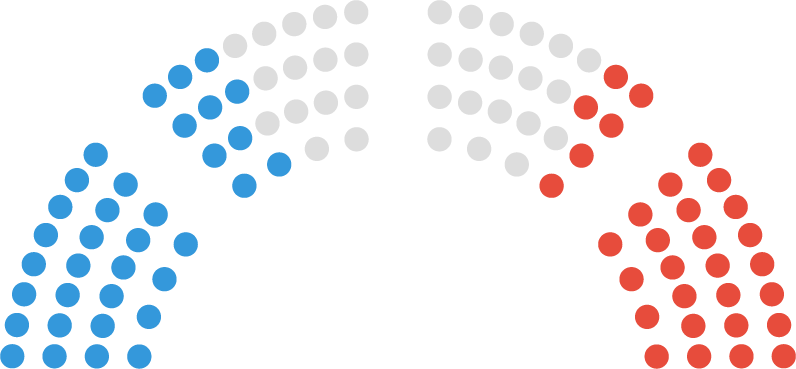
Security News
Oracle Drags Its Feet in the JavaScript Trademark Dispute
Oracle seeks to dismiss fraud claims in the JavaScript trademark dispute, delaying the case and avoiding questions about its right to the name.
d3-parliament-chart
Advanced tools

parliament / congress / legislature charts simplified
If you use NPM, npm install d3-parliament-chart. Otherwise, download the latest release.
# parliamentChart(data, width)
Given an array of objects and the width of the chart, parliamentChart() creates an object that can either be used to return processed seat locations or called on a d3 selection directly. The height is automatically set to half of the width. The most basic usage of this plugin:
d3.select('g').call(d3.parliamentChart([
{ color: 'blue' }, { color: 'blue' }, { color: 'green' }, { color: 'red' }
]))
Note: if data objects contain x and y values, this library will overwrite those values. If the chart is not big enough to accommodate the given settings, it will fit a half circle and any further data points will not be assigned an x / y value.
# pc.data(data)
If data is provided, replaces the raw data in this object. If data is not provided, this function acts like a getter and adds a x and a y attribute to each element in the array, which specifies the coordinates of each point. Seats are arranged in order of their polar degrees, left to right corresponding with 0 to data length respectively.
# pc.aggregatedData(data)
This function provides a more convenient method to set an aggregated version of the data. It takes an array of objects in which each object has a seats key that specifies how many seats this party / color has. For instance, you can pass in:
[{ seats: 48, color: 'blue' }, { seats: 2, color: 'black' }, { seats: 50, color: 'red' }]
# pc.width(width)
Sets the width used for calculating the points of the parliament chart.
# pc.sections(sections)
Sets the number of sections we want to show in this parliament chart.
# pc.sectionGap(sectionGap)
Sets the gap between sections for this parliament chart.
# pc.seatRadius(seatRadius)
Sets the radius of each seat in this parliament chart.
# pc.rowHeight(rowHeight)
Sets the height of each row for this parliament chart.
# pc.debug(debug)
Takes a boolean that if true, draws a set of guidelines for what this chart is supposed to look like.
Development mode enables you to work on this library locally. To run this repo in development mode, run
npm run dev
FAQs
parliament / congress / legislature charts simplified
We found that d3-parliament-chart demonstrated a not healthy version release cadence and project activity because the last version was released a year ago. It has 1 open source maintainer collaborating on the project.
Did you know?

Socket for GitHub automatically highlights issues in each pull request and monitors the health of all your open source dependencies. Discover the contents of your packages and block harmful activity before you install or update your dependencies.

Security News
Oracle seeks to dismiss fraud claims in the JavaScript trademark dispute, delaying the case and avoiding questions about its right to the name.

Security News
The Linux Foundation is warning open source developers that compliance with global sanctions is mandatory, highlighting legal risks and restrictions on contributions.

Security News
Maven Central now validates Sigstore signatures, making it easier for developers to verify the provenance of Java packages.